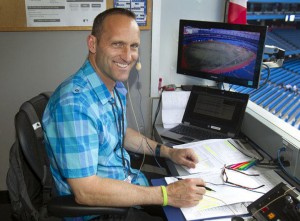Blue Jays Siddall says MLB has a conflicting proposal

Blue Jays play-by-play announcer Joe Siddall prepares to call a game during the 2014 season. Photo courtesy of the Toronto Blue Jays.
By Christian Bouchard
With offence on the decline and strikeouts soaring through the roof, Major League Baseball is looking to reduce the size of the strike zone.
Rule 2.00 of the Major League Baseball rulebook defines a strike zone as “that area over home plate the upper limit of which is a horizontal line at the midpoint between the top of the shoulders and the top of the uniform pants, and the lower level line at the hollow beneath the kneecap.”
MLB’s Playing Rules Committee must approve any changes to the rules. The committee will be paying close attention to the strike zone this upcoming season and changes could potentially be implemented as early as 2016. The last time MLB officially changed the definition of the strike zone came after the 1996 season.
The strike zone has expanded significantly since 2009, as a result of loss of offensive production. Runs per game fell to 4.07 in 2014, the lowest mark since 1981. According to research conducted by Hardball Times writer Joe Roegele, the size of the MLB strike zone has grown 40 square inches, from 435 in 2009 to 465 in 2014.
Joe Siddall, the current play-by-play announcer for the Toronto Blue Jays and former Detroit Tiger’s catcher, said he believes MLB is thinking of shrinking the strike zone in an attempt to increase offensive production.
“MLB wants to attempt to bring back some offence to the game,” said Siddall. “They think if they shrink the strike zone just a bit, it may give a small advantage back to the hitters and hopefully help teams score more runs.”
The problem, however, is that MLB is also looking for the length of games to be shortened.
“The problem is that the issue conflicts with the issue that they have with wanting more offence created at the same time,” said Siddall.
Siddall also said too much time is being wasted in game and with just a couple minor adjustments, MLB could have the best of both worlds.
“I would suggest MLB not to allow hitters to take unreasonable amounts of time out of the batters box,” said the retired catcher. “The same goes for pitchers on the mound and not allow mound visits to last too long. When the TV commercial is over, play is ready to be resumed immediately between innings.”
Whether the change to the strike zone happens or not or the average game time is reduced in the upcoming seasons, fans will likely play the biggest role in the final decision, according to Jeff Watkin, catcher for St. Clair College.
“Sports are about money now,” said Watkin. “People don’t pay to watch good defences or how a pitcher plays the game mentally against hitters. They want homeruns and runs scored.”
In 2013, 6.7 million people watched the annual MLB Homerun Derby, according to data obtained by SportsMediaWatch.com.
According to MLB, the strike zone itself is said to be the ultimate cause of diminishing offence, pitchers have also been getting significantly better over the years as well. Since 2009, a total of 24 hitters have been thrown.
MLB came up with a solution to give the hitters a better advantage back then. The pitchers mound was lowered from 15 to 10 inches and the strike zone was reduced.
“I think they should leave the strike zone and perhaps lower the mound again as they did after the 1968 season,” said Siddall. “This gave a slight advantage back to the hitters and pitchers Earned Runs Average went up.”


